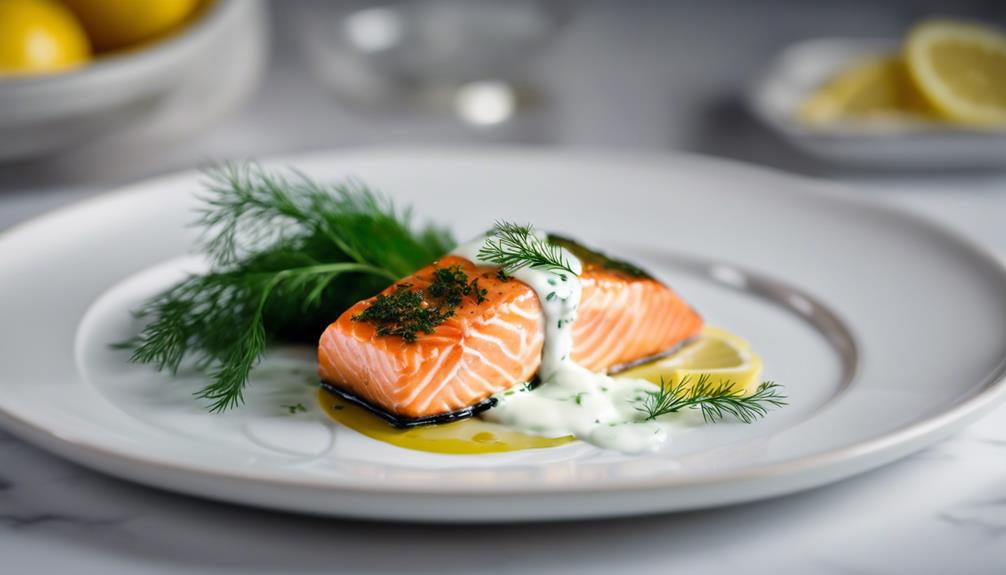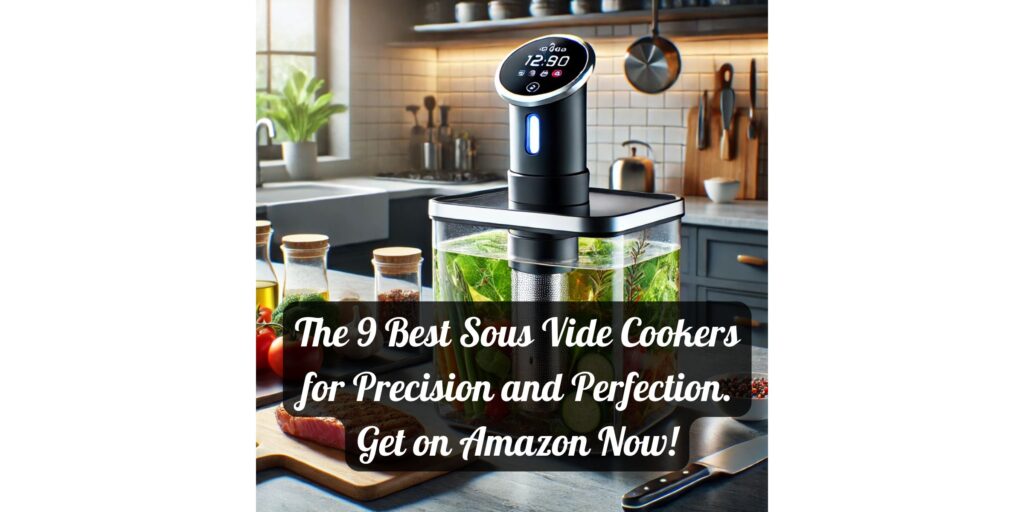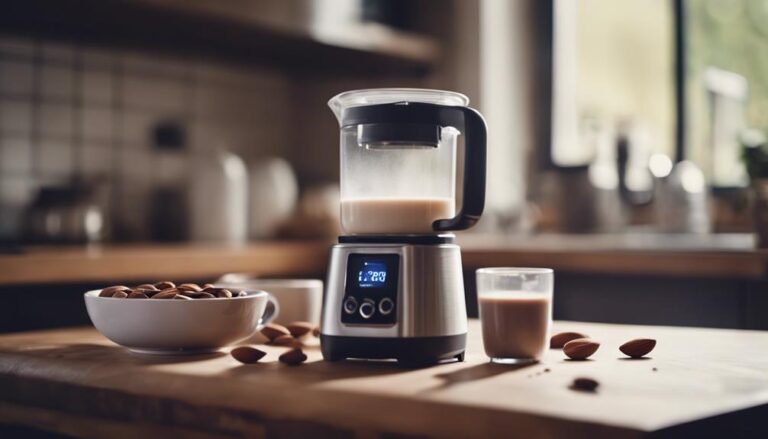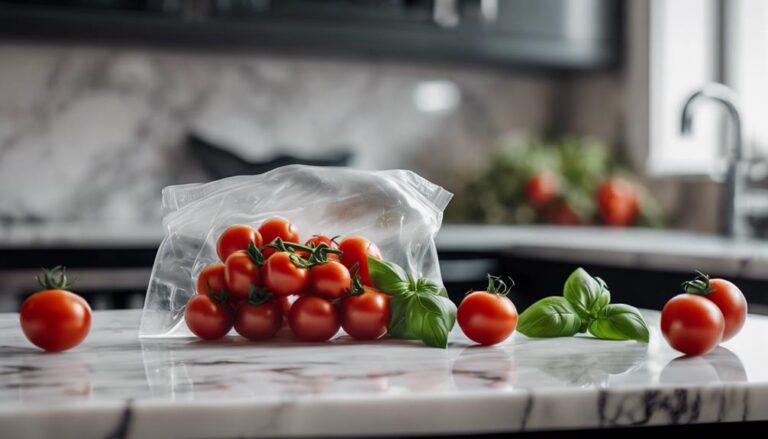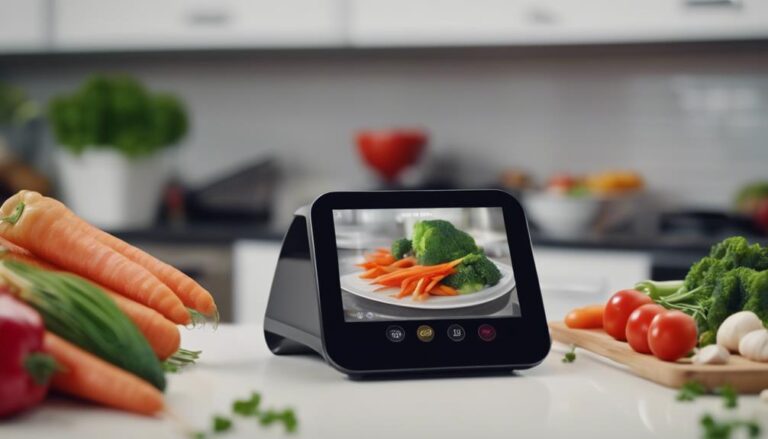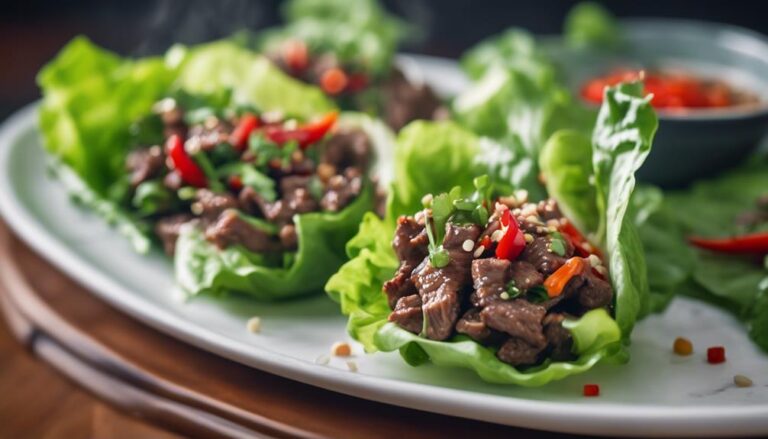Four-Point Sous Vide Salmon With Fresh Dill Yogurt
To create your Four-Point Sous Vide Salmon with fresh dill yogurt, start by vacuum-sealing your salmon fillets with salt, pepper, and a dash of lemon. Set your sous vide cooker between 115°F and 140°F, depending on how you like your salmon's texture—from sushi-like to flaky. Typically, a perfect doneness hits around 125°F for medium rare. While your salmon bathes, whisk together Greek yogurt, freshly chopped dill, lemon zest, and a pinch of salt for a creamy, herbaceous sauce. Once done, serve the salmon with a generous dollop of dill yogurt. Each bite will entice you to explore further the nuances of this culinary technique.
What You Will Learn Here
- Sous vide salmon at 115°F to 140°F to achieve desired doneness and texture.
- Use fresh dill in the yogurt for a tangy, herbaceous flavor complement.
- Seal salmon in vacuum or Ziplock bags to preserve moisture and flavor.
- Cook salmon precisely to tailor texture from sushi-like to flaky.
- Serve with dill yogurt to enhance the salmon's delicate flavors.
Origins of Sous Vide Cooking
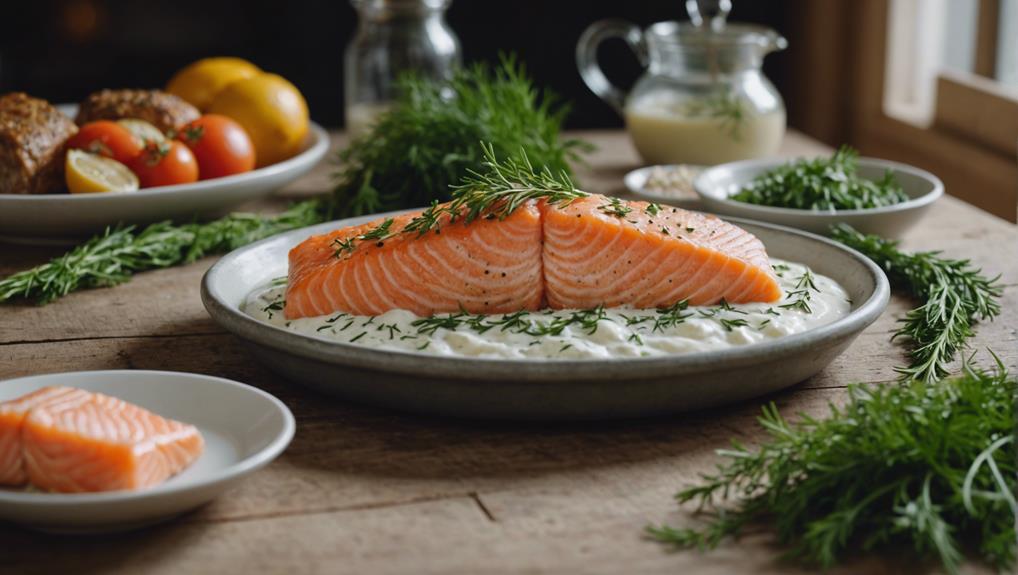
You might be intrigued to learn that sous vide, a technique synonymous with modern culinary precision, has roots stretching back to 1970s France, where it revolutionized the cooking of foie gras.
This method, literally meaning 'under vacuum,' allows chefs like Georges Pralus and Bruno Goussault to cook ingredients with unparalleled accuracy in temperature, ensuring flavors and textures are impeccably preserved.
As you explore the benefits of this precise cooking, you'll understand why it's become a cornerstone in contemporary kitchens, transforming not just how food is prepared but also elevating its quality to new heights.
Historical Cooking Techniques
Sous vide, a French term for 'under vacuum,' originated in the 1960s when chefs began experimenting with cooking vacuum-sealed food in precisely controlled water baths to enhance flavor and texture. Developed by Georges Pralus, this technique allowed high-end restaurants to serve consistently tender dishes with heightened flavors that were previously hard to achieve.
By sealing ingredients in vacuum-sealed bags, sous vide cooking minimizes moisture loss and guarantees even cooking at precise temperatures. This method not only preserved the natural aesthetics and nutrients of the food but also introduced a new world of texture possibilities to discerning diners.
Over time, the accessibility of affordable sous vide machines brought this gourmet technique into home kitchens, revolutionizing meal preparation for enthusiastic home chefs.
Modern Sous Vide Emergence
In the 1960s, French chefs pioneered sous vide cooking, a method that revolutionized the culinary world by allowing precise control over temperature, ensuring dishes are cooked evenly while retaining maximum flavor and nutrients.
Initially designed for foie gras, this technique, meaning 'under vacuum' in French, utilizes vacuum-sealed bags to encompass ingredients, maintaining their integrity. Georges Pralus, particularly, extended this method to proteins, perfecting the art of evenly cooked, succulent meats.
As sous vide cooking infiltrated fine dining restaurants, chefs capitalized on its ability to consistently deliver high-quality dishes. The precise temperature control is key, promoting the best retention of flavors and nutrients, ensuring every meal you serve is a demonstration of culinary excellence and care.
Benefits of Precise Cooking
By mastering sous vide's precise temperature controls, chefs can achieve remarkably tender and flavorful dishes every time. This technique, which began in France, allows you to maintain the integrity of ingredients like salmon, ensuring every serving is cooked to perfection.
| Feature | Benefit | Impact |
|---|---|---|
| Precise Control | Consistent Results | No more overcooked meals |
| Even Cooking | Tender and Juicy | Enhances texture and taste |
| Vacuum Sealing | Flavor Preservation | Intense and natural flavors |
| Temperature Range | Versatility | Cooks any dish perfectly |
| Convenience | Professional-Level Results | Achievable in your kitchen |
You'll find sous vide cooking not only preserves flavors but also offers the convenience and versatility needed to impress any guest with your culinary skills.
Essential Sous Vide Components
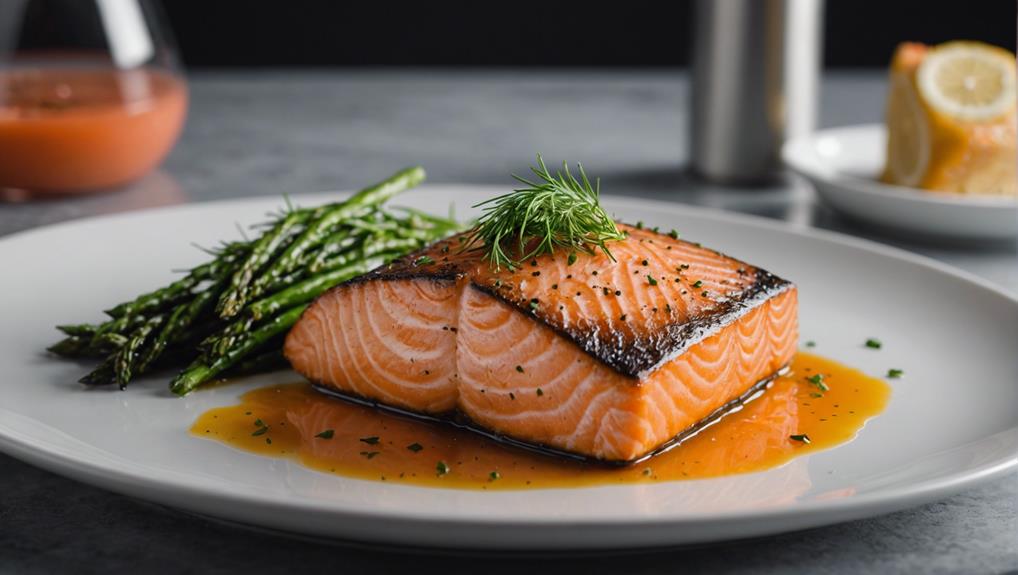
To achieve the perfect consistency and flavor in your sous vide salmon, you'll need a few key components, including a precision cooker and a vacuum sealer. Mastering your sous vide salmon recipe hinges on precision and attention to detail, ensuring that each bite is a reflection of your culinary care and skill.
When prepping your salmon, it's important to have these essential tools:
- Precision Cooker: This device allows you to maintain the ideal cooking temperature, which is important for achieving that just-right texture without overcooking.
- Vacuum Sealer or Ziplock Bag: Ensures that your salmon fillets are perfectly sealed to retain moisture and flavor during the cooking process. A Ziplock bag can be a great alternative if a vacuum sealer isn't available.
- Large Pot or Sous Vide Container: Provides a controlled environment for water circulation, ensuring even cooking.
- Cast Iron Skillet: Perfect for searing your salmon post-sous vide to add a deliciously crispy exterior that contrasts beautifully with the tender, moist interior.
- Fresh Ingredients: Fresh dill and lemon aren't just garnishes; they infuse your salmon with vibrant, fresh flavors that elevate the entire dish.
Top Sous Vide Dishes
As you explore the top sous vide dishes, you'll find the Classic Sous Vide Salmon Recipe, a staple that highlights the method's ability to lock in moisture and enhance the salmon's natural flavors.
The Herb-Infused Sous Vide Salmon introduces a bouquet of aromatic herbs that permeate the fish, offering a subtle yet complex taste profile.
Meanwhile, the Dill Yogurt Sous Vide Salmon combines the creamy tang of yogurt with the fresh, crisp notes of dill, creating a dish that's as visually appealing as it's delicious.
Classic Sous Vide Salmon Recipe
When making classic sous vide salmon, you'll cook the fillets at a precise 49C/120F for 45 minutes to guarantee a tender texture that's both moist and flaky. This method, combined with the right seasoning and techniques, guarantees each bite is a delight.
- Vacuum sealed with lemon and dill, the salmon's flavor is deeply infused throughout the cooking process.
- Gently placing the salmon into the sous vide bath, ensuring even cooking without the risk of drying out.
- The ritual of searing the salmon in a hot buttery pan to achieve that perfect, crispy skin.
- Drizzling fresh herbs over the finished dish to enhance the aromatic experience.
- Serving with a dollop of fresh dill yogurt, adding a creamy, tangy contrast to the rich salmon.
Herb-Infused Sous Vide Salmon
Enhancing your sous vide salmon with fresh dill and other herbs not only guarantees a tender, perfectly cooked dish but also fortifies its flavor. When you use your sous vide machine, the precise cooking temperature allows every herb, especially the fresh dill, to deeply infuse into the salmon fillets, creating layers of aromatic complexity. The sous vide technique ensures that these flavors are perfectly preserved and intensified.
- Aromatic Fresh Dill: Envelops the salmon with a vibrant, herbal freshness.
- Silky Salmon Texture: Achieved through low-temperature cooking.
- Herb-Infused Elegance: Each fillet is a tribute to the finesse of flavor layering.
- Vivid Color Retention: The herbs maintain their bright, appealing hues.
- Subtle Flavor Release: Gradual infusion enhances without overpowering.
Dill Yogurt Sous Vide Salmon
Building on the herb-infused theme, pairing sous vide salmon with a dill yogurt sauce offers a creamy, tangy twist that perfectly complements the fish's silky texture. By cooking in a precision-controlled water bath, you're guaranteed a tender and moist result every time. The dill yogurt sauce, with its creamy dill freshness, elevates the dish, making it not just a meal but an experience.
- Imagine the salmon emerging from the sous vide, its texture remarkably tender.
- Envision drizzling the silky, tangy dill yogurt sauce over the warm, perfectly cooked fillet.
- Picture the vibrant green of fresh dill speckling the creamy sauce.
- Feel the satisfying contrast between the warm salmon and the cool, fresh sauce.
- Taste the harmonious blend of subtle fish flavors lifted by the bold, fresh flavor of dill.
Optimal Sous Vide Temperatures
When you set your sous vide to the ideal temperature of 120°F, your salmon emerges tender and moist, perfect for those who savor a melt-in-your-mouth experience.
Adjusting the heat slightly to 109.9°F or 122°F can notably alter the texture, giving you either a sushi-like feel or a softer, more delicate bite, respectively.
Ideal Salmon Temperatures
To achieve your desired doneness and texture in sous vide salmon, you can finely tune the cooking temperature between 115°F and 140°F.
When you set the sous vide temperature at the lower spectrum, around 115°F to 125°F, you're aiming for that perfect medium-rare to medium doneness. This range is ideal if you're looking to impress with a tender, gently cooked salmon that pairs exquisitely with fresh dill yogurt.
The precise control offered by sous vide means you can customize each fillet to suit your guests' preferences, ensuring every plate is a delight. Whether you prefer your salmon soft and lush or slightly firmer, adjusting the temperature allows you to master the texture, enhancing both the flavor and the dining experience.
Temperature Impact on Texture
Understanding how temperature affects the texture of your salmon is key as you aim for that perfect sous vide preparation. Sous vide cooking offers precise temperature control, enabling you to hit the ideal temperature for the texture you desire.
For a soft, sushi-like texture, set your device to 109.9°F. If you prefer your salmon soft yet slightly firmer, 122°F is your target. Want it firmer still? Opt for 126.5°F. For those who love a flakier texture, 140°F will achieve those results.
Experimenting with temperatures allows you to provide customized results tailored to individual preferences, ensuring that your sous vide salmon not only meets but exceeds expectations. Each temperature adjustment subtly alters the salmon texture, enhancing both the dish's elegance and your culinary reputation.
Comparing Cooking Durations
How long should you sous vide your salmon to achieve the perfect texture at each temperature setting?
For that sushi-like delicacy, maintain 109.9°F for about 45 minutes, ensuring a barely-cooked, tender bite.
Craving something softer? Set the sous vide to 122°F and let your salmon bathe for 30 to 40 minutes to accentuate its buttery texture, ideal for pairing with fresh dill yogurt.
If a firmer bite suits your guest's preference, 126.5°F for 30 minutes will do the trick, offering a slight chew without losing moisture.
For those who adore a classic, flaky salmon, 140°F for about 25 minutes achieves that traditional texture.
This customization in cooking durations lets you tailor each serving to perfection, enhancing your culinary repertoire with precision.
Final Thoughts
With this Four-Point Sous Vide Salmon and Fresh Dill Yogurt recipe, you'll master the art of perfectly textured, flavor-packed salmon every time. Utilizing the sous vide method, you guarantee controlled cooking that delivers consistently tender and succulent salmon fillets, eliminating the guesswork often associated with traditional methods.
The fresh dill yogurt sauce adds a tangy, herbaceous complement that elevates the natural flavors of the salmon, making each bite a delightful experience. What makes this dish truly stand out is its customizable nature; you can experiment with various herbs and seasonings to tailor the dish to your guests' preferences, ensuring that each serving isn't just nourishing but also aligned with their taste.
As you serve this restaurant-quality meal, remember that the precision of sous vide cooking allows you to focus more on your guests rather than worrying about overcooking or undercooking the salmon. This method frees you up to engage in meaningful conversations, making the dining experience enjoyable and stress-free. The combination of juicy salmon and vibrant dill yogurt sauce not only satisfies the palate but also offers a visually appealing dish that's sure to impress.
Frequently Asked Questions
What Temperature Do You Sous Vide Salmon At?
You'll sous vide salmon at temperatures ranging from 109.9°F to 140°F, depending on your texture preference, from sushi-like to flaky. Consider seasoning effects, vacuum sealing techniques, and post-searing for best doneness and flavor.
What Is the Best Temperature to Sous Vide Fish?
To sous vide fish ideally, aim for 120°F to 130°F, ensuring moist texture and safety. Vacuum sealing enhances flavor, and precise equipment manages doneness. Adjust times based on desired texture variations.
Can You Sous Vide Salmon Too Long?
You can sous vide salmon too long, risking texture changes and flavor loss. While cooking precision maintains moisture and nutrients, overly extended times might lead to protein breakdown without added safety concerns.
Do You Need to Brine Salmon Before Sous Vide?
You don't *need* to brine salmon before sous vide, but doing so enhances flavor and texture. Consider quick brine methods or alternative liquids to boost moisture retention and tweak the salt concentration.
Conclusion
Now that you've mastered the essentials, your sous vide salmon will be a standout. Gently cooked to perfection, its texture is unmatched—silky and tender.
The fresh dill yogurt adds a vibrant, herby punch that elevates each bite. Remember, maintaining precise temperatures is key to locking in those fabulous flavors.
Immerse yourself in this culinary technique, explore its depths, and watch your dishes transform. Get creative, experiment with flavors, and enjoy the journey to sous vide mastery.
